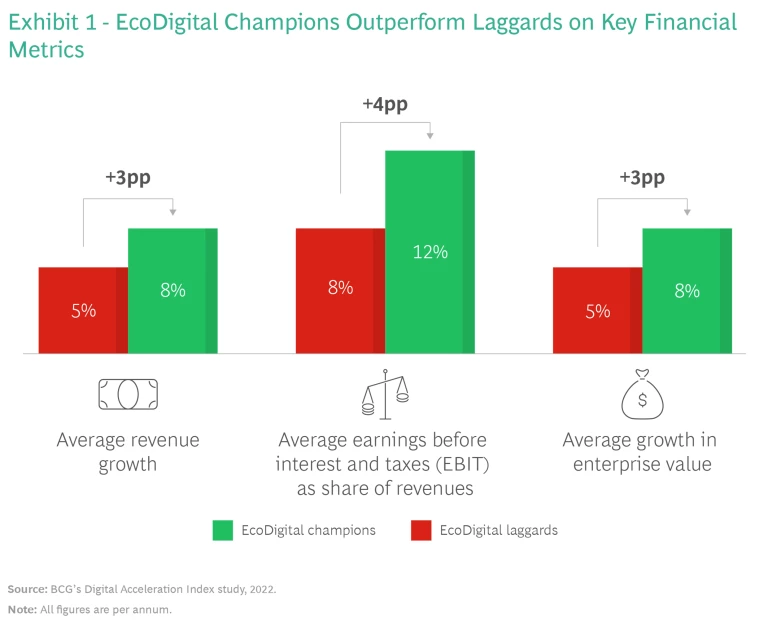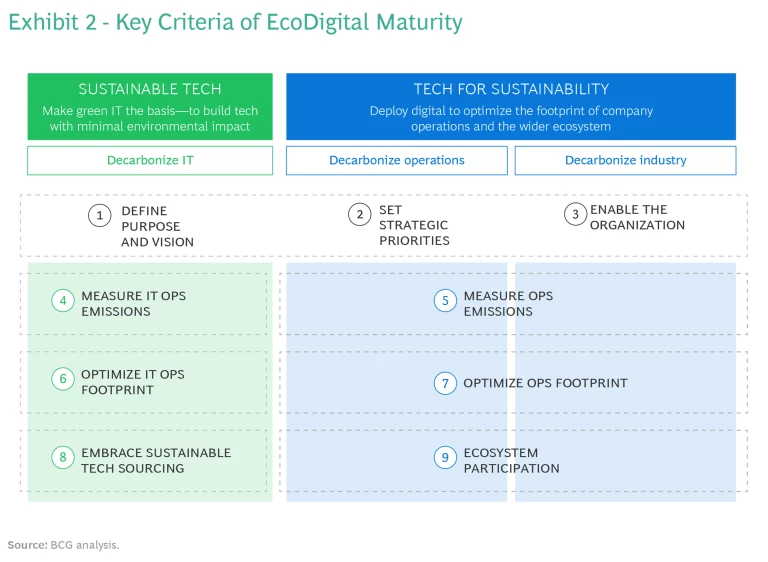Sustainability and technology have a close relationship, but there is room to tighten the bond—and good reason to do so. For most companies, sustainability is a welcome outcome of digital transformation. But when it helps drive the journey, businesses can unlock both economic and environmental value.
The EcoDigital advantage: Sustainability driving the digitization journey unlocks dividends.
We call this the EcoDigital advantage and already it’s paying dividends for companies that have adopted it. BCG’s sixth annual Digital Acceleration Index (DAI) study, a global survey of 2,700 executives, reveals that EcoDigital champions—the companies best poised to leverage digital to advance sustainability—saw a boost in overall business performance. And they achieved this while accelerating their path toward net zero.
EcoDigital champions reap benefits, but they also sow them, helping the world meet sustainability goals. So how can more businesses join their ranks? Some key principles can guide the way.
Green Tech Is Good Tech
To assess EcoDigital maturity, we focused on a subset of DAI criteria that help gauge how—and how successfully—companies integrate sustainability into their digital strategy. Those companies that scored in the top quartile were deemed EcoDigital champions.
Tellingly, 60% of champions also were in the top quartile on the DAI, evidencing highly mature digital and AI capabilities. This overlap between digital leaders and EcoDigital leaders demonstrates that green tech is good tech. Financial metrics strengthen the case. Compared to EcoDigital laggards (those organizations scoring in the bottom quartile), champions saw higher growth in revenue, enterprise value, and earnings before interest and taxes. (See Exhibit 1.)

This value creation is particularly important as net zero transformations require investment as well as commitment. And the money isn’t always there. By creating economic value, EcoDigital champions help fund the journey. At the same time, they demonstrate that sustainability doesn’t come at the cost of financial performance—sparking buy-in for current and future initiatives.
Many companies have ambitions to step up their EcoDigital game. Our study found that 59% of companies aspire to become EcoDigital champions by 2025. Most businesses recognize that technology and data can be powerful sustainability enablers. Digitizing operations, using new materials, deploying AI to predict (and help reduce) the environmental impact of a product—the list goes on. By our estimates, EcoDigital transformation can reduce carbon emissions by 30% to 70%.
EcoDigital transformation can reduce carbon emissions by 30% to 70%.
But many won’t fulfill their ambition. Looking at previous DAI studies and the progress organizations made over time, we see that improvement tends to be incremental, not dramatic. Indeed, we estimate that by 2025 only 38% of survey respondents will have the EcoDigital maturity of current champions.
By integrating sustainability into digital strategy, companies can go forward and raise their EcoDigital maturity higher, faster. We’ve found that getting this right means embracing the following principles:
- Sustainable operations: Leverage digital enablers—such as AI, the Internet of Things, and digital twins—to optimize the company’s environmental footprint. As they develop their digital future, EcoDigital champions ask how they can deploy technology to meet both strategic and environmental goals.
- Green IT: Deploy energy efficient technology and adopt infrastructure practices that decarbonize the IT landscape. By using equipment and processes that consume less energy, create less waste, last longer, and are utilized more efficiently (for example, using one server at 100% capacity instead of five servers at 20%), EcoDigital champions can scale their enablers in a sustainable way.
- New, sustainability-driven growth: seize opportunities to use the data, insights, and innovations around sustainability to create new B2B or B2C offerings. EcoDigital champions look beyond company walls, mitigating environmental impact across the broader ecosystem. For savvy players, this can lead to new opportunities for growth. Sustainability, in effect, becomes a business model. One example: Schneider Electric’s EcoStruxure platform, which helps customers optimize their energy use. It has helped the company evolve from a traditional B2B electrical distribution equipment manufacturer into a leader in sustainability solutions.
How to Turn Sustainability from an Outcome to a Driver
Transformations succeed when you know your starting point, know where you want to go, and have a flexible and efficient way of getting there. The best approaches create value early in the journey, build capabilities steadily, and stress agility and continuous improvement.
With this in mind, we’ve created a four-step approach to help companies integrate the principles of EcoDigital advantage into their digital vision.
ASSESS. The EcoDigital Advantage Index (E-DAI) assesses the factors that determine EcoDigital maturity, such as how a company integrates sustainability into its digital strategy, leverages digital enablers, measures results, and engages with suppliers and the broader ecosystem on sustainability. (See Exhibit 2.)

We used this assessment tool to benchmark survey participants and identify EcoDigital champions, as well as laggards. But for individual companies, the E-DAI can be a powerful diagnostic: a pulse check on how they are leveraging digital to advance sustainability. It reveals what businesses are doing well and what they could be doing better.
PLAN. With a baseline in hand, companies can start developing a roadmap for becoming EcoDigital champions. While routes will vary, the most effective have a common bearing: developing capabilities—and value—steadily, through use cases. These are the new products, applications, or processes that help optimize the company’s environmental footprint (or that of the broader ecosystem). Two examples are analytics that forecast energy use and a platform that collects sustainability data from suppliers.
It is essential to get the sequence right—the order in which to implement use cases. Quick successes that are relatively easy to launch and generate clear value can create momentum (and funding) for more ambitious use cases. The right sequence also helps companies build capabilities in a steady, savvy way. EcoDigital champions consider feasibility and value-creation potential when prioritizing use cases, but they also emphasize: "What can I build today that helps me build what I need tomorrow?"
What can I build today that helps me build what I need tomorrow?
A cross-functional approach, where business and technology leaders come together to align on strategic goals, sustainability opportunities, and technology enablers (including emerging and deep tech) helps ensure that businesses develop the right use cases in the right order.
DELIVER Avoid putting use cases on hold while deploying green IT. The faster companies launch products, even in an early form, the sooner they can create both economic and environmental value. That’s why we recommend a parallel approach: greening the foundation while developing use cases, instead of before.
For many companies, green IT has been a weak spot. While champions, on average, achieved a score of 76 (out of a possible 100) for sustainable technology, laggards came in at just 21. And across participants, we see a broad mandate for improvement: a 42-point gap between where companies were in 2022 and where they hope to be in 2025. A parallel approach—creating value while greening the foundation—can generate the momentum needed to meet that ambitious target.
IMPROVE. Transformations are dynamic. Companies that succeed continually measure performance and adjust as necessary, using fast, frequent cycles of feedback, analysis, and recalibration. EcoDigital champions look to raise their ecosystem as well as themselves, participating in (and even launching) initiatives to set standards and share best practices. This kind of wide-scale cooperation can foster sustainable supply chains, circularity, and other paradigms for mitigating environmental impact—sparking wins for company and society alike.
Now is the time to make sustainability and digital a joint priority. The sooner companies embrace this new approach to digital transformation, the faster they can close the gap between where they are on sustainability and where they want to be. It’s a goal worth reaching. EcoDigital champions can create an advantage for themselves—and an even bigger one for the planet.




